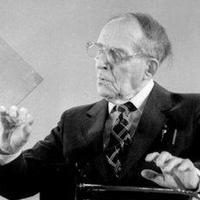Leon Theremin
Leon Theremin was a Russian and Soviet inventor, most famous for his invention of the theremin, one of the first electronic musical instruments and the first to be mass-produced. He also worked on early television research.
Leon Theremin invented one of the world’s first and most unique electronic musical intruments: the aetherphone, better known as Thermin. He was a youthful enthusiast of both music and physics. After enrolling at the University of Petrograd, he concentrated his studies in the nascent field of electrical engineering. There, he was repairing a radio when he conceived the idea of an essentially electronic musical instrument that would produce purely electronic music.
In 1918, Theremin built the prototype of his “aetherphone.”
The key to the aetherphone’s sound is the principle of heterodyning: when two signals of close but different frequency are mixed, a new signal results whose frequency is equal to the difference of the two original signals. Alone, the signals produced by the Theremin’s oscillators are too high-pitched for the human ear to hear; but when those signals combine, the resulting signal can be heard, and more importantly can be varied by the position of the “musician” standing between the two antennas. Specifically, the player waves his or her hands near the straight antenna to control pitch (the range is about 2 1/2 octaves on either side of middle C), and near the looped antenna to control volume (bringing the hand within an inch of the antenna cuts off the sound completely).
Theremin’s invention is still the only musical instrument, which is played without any physical contact. The sound it can produce runs from a drone to a whine, but is always somewhat otherworldly. For this reason, although Theremin himself and others have composed complex musical works in the classical style for the Theremin (as the device is better known), it is best recognized for its prominence in the soundtrack to various early Hollywood sci-fi movies, like “The Day the Earth Stood Still.” However, the Theremin does make a memorable pop music appearance in the background of the Beach Boys’ “Good Vibrations.”
Theremin first demonstrated his instrument to a group of Russian physicists in 1920; in 1922, he performed for Lenin. Five years later, he toured Europe, playing symphonies he had composed “for aetherphone and orchestra” to standing-room-only audiences. In December of 1927, he came to New York, where he played for Rachmaninoff and Toscanini, among others. Capitalizing on his success, Theremin set up a lab and music studio in New York. In 1928, he played with the New York Philharmonic, and he also earned a U.S. patent (#1,661,058). The next year, RCA began to manufacture and market the “thereminvox” under license.
The instrument was not a commercial success, . However, Theremin did find a virtuoso in his fellow Russian émigré Clara Rockmore: no one has ever been able to match the “aerial fingering” with which she could coax astonishingly precise and subtle sounds from the instrument.
For ten years Theremin worked in New York. With the help of Clara Rockmore, he developed what would today be called “performance art,” featuring stages which automatically reacted to dancers’ movements with varied patterns of sound and light. Then, in 1938, Theremin was kidnapped by the KGB and returned to Russia. Forced to abandon his music, he spent a year in prison, and later developed listening devices for the Soviet secret police. Meanwhile, RCA scrapped its stock of Theremins in order to provide raw materials to the U.S. war effort.
In 1991, at the age of 95, Theremin returned to the U.S., where he was reunited with Clara Rockmore and gave a number of concerts. He then went back to Russia, and died in Moscow two years later in November of 1993. But the Theremin has enjoyed a recent resurgence in popularity, due to its inventor’s visit and a documentary film of his career made at that time. Numerous sites on the World Wide Web testify that Leon Theremin’s “music of an alternate universe” still has a strong appeal.

Leon Theremin
Date of Birth: 28 Aug 1896
Birth Place: Saint Petersburg, Russia
Proffession: Inventor
Nationality: Indian
Death: 3 November 1993, Moscow, Russia


